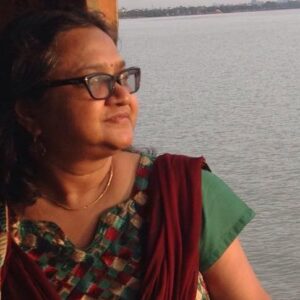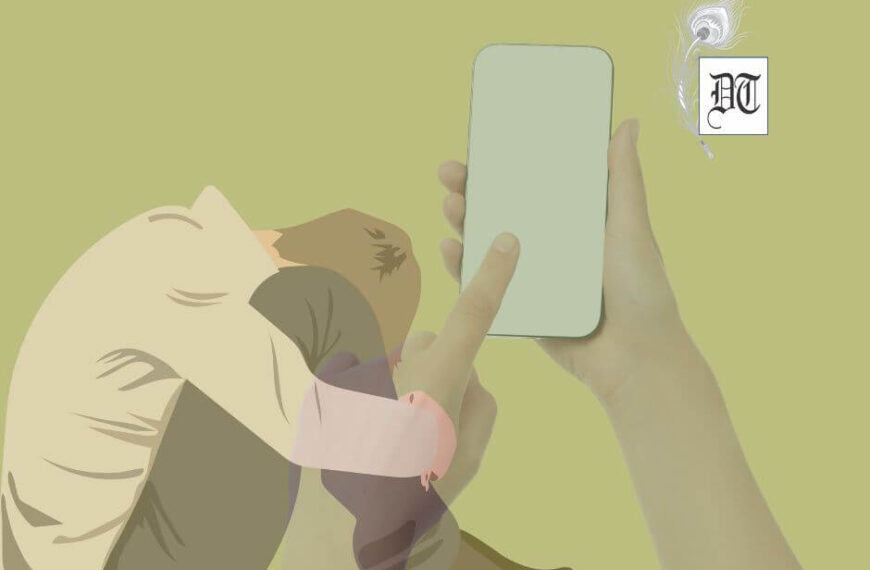Suhasini is a Tangail cotton with mooga stripes across her, some paisleys carefully woven like an alpana across the threshold, when you welcome Goddess Lakshmi or a bride to the household. Suhasini means the one with a winsome smile, and she came to me from a neighbour. Dr. Noorjahan Adhikary, another smiling lady, dimpled, light-eyed, beautiful and loving. My mother had bought another saree for the phoolshojja (nuptial night), but I liked this grand cotton for its comfort. So I wore this, instead of the sari my mother gave. Nilakshi shares her association with a red saree, exclusively in Different Truths.
I’m about to share a saree story with you. I’ve taken special care to name my sarees. It’s true I don’t call them by their names when I take them off their hangers. But they seem to acquire an identity, as I write about them – rather one of them, to begin with.
When I see the sarees, their names emerge out of their softness, colour, feel and the moods, I find myself in as I see them.. And memories too. Memory is a distinct identity marker. I dwell in the fond memories of mothers and their love, gifts, hand-me- downs, functions, festivals, and weddings most of all.
This saree is Suhasini. She’s a Tangail cotton with mooga stripes across her, some paisleys carefully woven like an alpana across the threshold, when you welcome Goddess Lakshmi or a bride to the household. Suhasini means the one with a winsome smile, and she came to me from a neighbour. Dr. Noorjahan Adhikary, another smiling lady, dimpled, light-eyed, beautiful and loving. My mother had bought another saree for the phoolshojja (nuptial night), but I liked this grand cotton for its comfort. So I wore this, instead of the sari my mother gave. Suhasini, a sari from another mother!
I wore Suhasini when I spent my first night on the nuptial bed! Suhaag raat as you call it. Phoolshojja in Bangla. I was tired and the make-up had vanished. The photos were hideous but I still think I looked beautiful because of the saree.
Red, red, red… like the colour of love. Like the sindoor on my head. Like flaming passions. Like the roses that were strewn on the bed… filling my senses with their heady fragrance along with the rajanigandha, the flower adopted by Bengalis for weddings. And like my heart, which must have been red … filled with the gushing blood of innocence and sweet desire. To be loved and cared for by the man I knew for ten months.
I remember walking into the house smiling. The photos show that! Suhasini appears such an appropriate name, as I smiled through most of the wedding and after, the years spent in Mumbai. Smiling always, through the trials and tribulations that I faced alone.
There’s nothing more magical than a smile and Suhasini makes me happy, as you see in the photos, even today, 30 years later, as I wear her. Not a shade less bright, the mooga shining golden yellow, the paisleys in their neat rows undercutting the linearity of the stripes.
Even today, I’m the one always joking, mimicking, and teasing… the clown at the staff room table. And even on that night, that’s what we did. We smiled and laughed. And of course kissed like novices. And cracked walnuts and ate them! Walnuts, which a brother from another mother gave! Ghulam Hassan, a Kashmiri Shawlwalla, who called my mother Maa, and came to our house anytime, sale or no sale, ate, had chai and chatted as if we were family.
So we ate those walnuts which cra-ca- cracked out of their shells as he broke them in one shot and we laughed at the din we made! Like two college friends, on our suhaag raat! I loved that. We were reserving intimacy for the honeymoon, in Kathmandu, three days later.
But laughing like kids, I rubbed the sindoor off his kurta and he tied up my hair, which was long and soft and silky and refused to stay pinned in a neat bun! Because why should people say anything, and nudge and whisper at our dishevelment when all we had really done was only laugh and smile and smile? Me in my Suhasini…
©Nilakshi Roy
Photo collage by the author and from the internet.




 By
By
 By
By
 By
By
 By
By